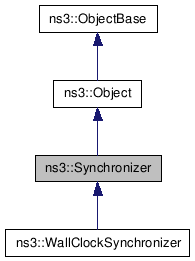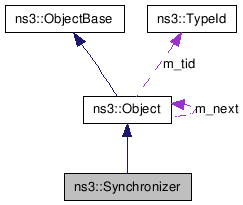ns3::Synchronizer Class Reference
Base class used for synchronizing the simulation events to some real time "wall clock.". More...
#include <synchronizer.h>


Public Member Functions | |
| bool | Realtime (void) |
| Return true if this synchronizer is actually synchronizing to a realtime clock. The simulator sometimes needs to know this. | |
| uint64_t | GetCurrentRealtime (void) |
| Retrieve the value of the origin of the underlying normalized wall clock time in simulator timestep units. | |
| void | SetOrigin (uint64_t ts) |
| Establish a correspondence between a simulation time and the synchronizer real time. | |
| uint64_t | GetOrigin (void) |
| Retrieve the value of the origin of the simulation time in simulator timestep units. | |
| int64_t | GetDrift (uint64_t ts) |
| Retrieve the difference between the real time clock used to synchronize the simulation and the simulation time (in simulator timestep units). | |
| bool | Synchronize (uint64_t tsCurrent, uint64_t tsDelay) |
| Wait until the real time is in sync with the specified simulation time or until the synchronizer is Sigalled. | |
| void | Signal (void) |
| Tell a posible simulator thread waiting in the Synchronize method that an event has happened which demands a reevaluation of the wait time. This will cause the thread to wake and return to the simulator proper where it can get its bearings. | |
| void | SetCondition (bool) |
| Set the condition variable that tells a posible simulator thread waiting in the Synchronize method that an event has happened which demands a reevaluation of the wait time. | |
| void | EventStart (void) |
| Ask the synchronizer to remember what time it is. Typically used with EventEnd to determine the real execution time of a simulation event. | |
| uint64_t | EventEnd (void) |
| Ask the synchronizer to return the time step between the instant remembered during EventStart and now. Used in conjunction with EventStart to determine the real execution time of a simulation event. | |
Static Public Member Functions | |
| static TypeId | GetTypeId (void) |
| This method returns the TypeId associated to ns3::Object. | |
Protected Member Functions | |
| virtual void | DoSetOrigin (uint64_t ns)=0 |
| Establish a correspondence between a simulation time and a wall-clock (real) time. | |
| virtual bool | DoRealtime (void)=0 |
| Return true if this synchronizer is actually synchronizing to a realtime clock. The simulator sometimes needs to know this. | |
| virtual uint64_t | DoGetCurrentRealtime (void)=0 |
| Retrieve the value of the origin of the underlying normalized wall clock time in simulator timestep units. | |
| virtual bool | DoSynchronize (uint64_t nsCurrent, uint64_t nsDelay)=0 |
| Wait until the real time is in sync with the specified simulation time. | |
| virtual void | DoSignal (void)=0 |
| Declaration of the method used to tell a posible simulator thread waiting in the DoSynchronize method that an event has happened which demands a reevaluation of the wait time. | |
| virtual void | DoSetCondition (bool)=0 |
| Declaration of the method used to set the condition variable that tells a posible simulator thread waiting in the Synchronize method that an event has happened which demands a reevaluation of the wait time. | |
| virtual int64_t | DoGetDrift (uint64_t ns)=0 |
| Declaration of method used to retrieve drift between the real time clock used to synchronize the simulation and the current simulation time. | |
Private Member Functions | |
| uint64_t | TimeStepToNanosecond (uint64_t ts) |
| Convert a simulator time step (which can be steps of time in a user-specified unit) to a normalized time step in nanosecond units. | |
| uint64_t | NanosecondToTimeStep (uint64_t ns) |
| Convert a normalized nanosecond count into a simulator time step (which can be steps of time in a user-specified unit). | |
Detailed Description
Base class used for synchronizing the simulation events to some real time "wall clock.".The simulation clock is maintained as a 64-bit integer in a unit specified by the user through the TimeStepPrecision::Set function. This means that it is not possible to specify event expiration times with anything better than this user-specified accuracy. We use this clock for the simulation time.
The real-time clock is maintained as a 64-bit integer count of nanoseconds.
The synchronization between the simulation clock and the real-time clock is maintained using a combination of sleep-waiting, busy-waiting and a feedback loop.
Member Function Documentation
| virtual void ns3::Synchronizer::DoSetCondition | ( | bool | ) | [protected, pure virtual] |
Declaration of the method used to set the condition variable that tells a posible simulator thread waiting in the Synchronize method that an event has happened which demands a reevaluation of the wait time.
- See also:
- Synchronizer::SetCondition
Implemented in ns3::WallClockSynchronizer.
| virtual void ns3::Synchronizer::DoSignal | ( | void | ) | [protected, pure virtual] |
Declaration of the method used to tell a posible simulator thread waiting in the DoSynchronize method that an event has happened which demands a reevaluation of the wait time.
- See also:
- Synchronizer::Signal
Implemented in ns3::WallClockSynchronizer.
| uint64_t ns3::Synchronizer::EventEnd | ( | void | ) |
Ask the synchronizer to return the time step between the instant remembered during EventStart and now. Used in conjunction with EventStart to determine the real execution time of a simulation event.
- See also:
- Synchronizer::EventStart
TimeStepPrecision::Get
| void ns3::Synchronizer::EventStart | ( | void | ) |
Ask the synchronizer to remember what time it is. Typically used with EventEnd to determine the real execution time of a simulation event.
- See also:
- Synchronizer::EventEnd
TimeStepPrecision::Get
| uint64_t ns3::Synchronizer::GetCurrentRealtime | ( | void | ) |
Retrieve the value of the origin of the underlying normalized wall clock time in simulator timestep units.
- Returns:
- The normalized wall clock time (in simulator timestep units).
- See also:
- TimeStepPrecision::Get
| int64_t ns3::Synchronizer::GetDrift | ( | uint64_t | ts | ) |
Retrieve the difference between the real time clock used to synchronize the simulation and the simulation time (in simulator timestep units).
- Parameters:
-
ts Simulation timestep from the simulator interpreted as current time in the simulator.
- Returns:
- Simulation timestep (in simulator timestep units) minus origin time (stored internally in nanosecond units).
- See also:
- TimeStepPrecision::Get
| uint64_t ns3::Synchronizer::GetOrigin | ( | void | ) |
Retrieve the value of the origin of the simulation time in simulator timestep units.
- Returns:
- The simulation time used as the origin (in simulator timestep units).
- See also:
- TimeStepPrecision::Get
| static TypeId ns3::Synchronizer::GetTypeId | ( | void | ) | [static] |
This method returns the TypeId associated to ns3::Object.
No Attributes defined for this type.
No TraceSources defined for this type.
Reimplemented from ns3::Object.
| bool ns3::Synchronizer::Realtime | ( | void | ) |
Return true if this synchronizer is actually synchronizing to a realtime clock. The simulator sometimes needs to know this.
- Returns:
- True if locked with realtime, false if not.
| void ns3::Synchronizer::SetCondition | ( | bool | ) |
Set the condition variable that tells a posible simulator thread waiting in the Synchronize method that an event has happened which demands a reevaluation of the wait time.
- See also:
- Synchronizer::Signal
| void ns3::Synchronizer::SetOrigin | ( | uint64_t | ts | ) |
Establish a correspondence between a simulation time and the synchronizer real time.
This method is expected to be called at the "instant" before simulation begins. At this point, simulation time = 0, and a set = 0 in this method. We then associate this time with the current value of the real time clock that will be used to actually perform the synchronization.
Subclasses are expected to implement the corresponding DoSetOrigin pure virtual method to do the actual real-time-clock-specific work of making the correspondence mentioned above.
- Parameters:
-
ts The simulation time we should use as the origin (in simulator timestep units).
- See also:
- TimeStepPrecision::Get
TimeStepPrecision::DoSetOrigin
| void ns3::Synchronizer::Signal | ( | void | ) |
Tell a posible simulator thread waiting in the Synchronize method that an event has happened which demands a reevaluation of the wait time. This will cause the thread to wake and return to the simulator proper where it can get its bearings.
| bool ns3::Synchronizer::Synchronize | ( | uint64_t | tsCurrent, | |
| uint64_t | tsDelay | |||
| ) |
Wait until the real time is in sync with the specified simulation time or until the synchronizer is Sigalled.
This is where the real work of synchronization is done. The Time passed in as a parameter is the simulation time. The job of Synchronize is to translate from simulation time to synchronizer time (in a perfect world this is the same time) and then figure out how long in real-time it needs to wait until that synchronizer / simulation time comes around.
Subclasses are expected to implement the corresponding DoSynchronize pure virtual method to do the actual real-time-clock-specific work of waiting (either busy-waiting or sleeping, or some combination thereof) until the requested simulation time.
- Parameters:
-
tsCurrent The current simulation time (in simulator timestep units). tsDelay The simulation time we need to wait for (in simulator timestep units).
- Returns:
- True if the function ran to completion, false if it was interrupted by a Signal.
- See also:
- TimeStepPrecision::Get
The documentation for this class was generated from the following file:
- src/simulator/synchronizer.h
 1.5.8
1.5.8